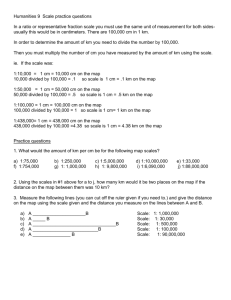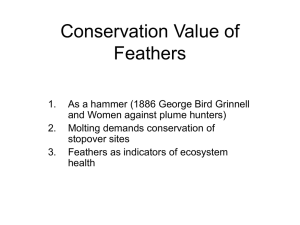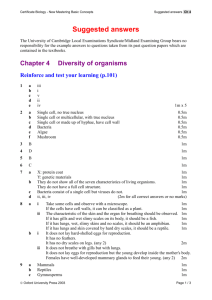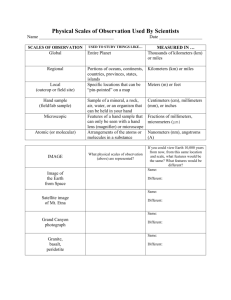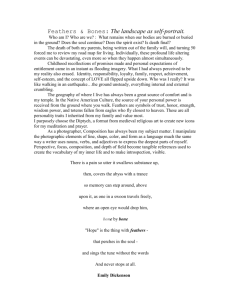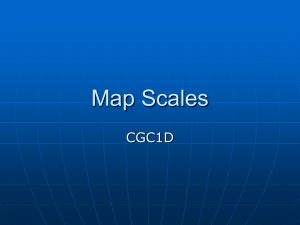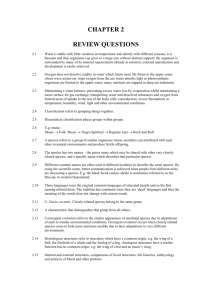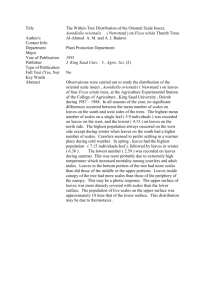Histology and Ontogeny of Scales, Hair and Feathers
advertisement
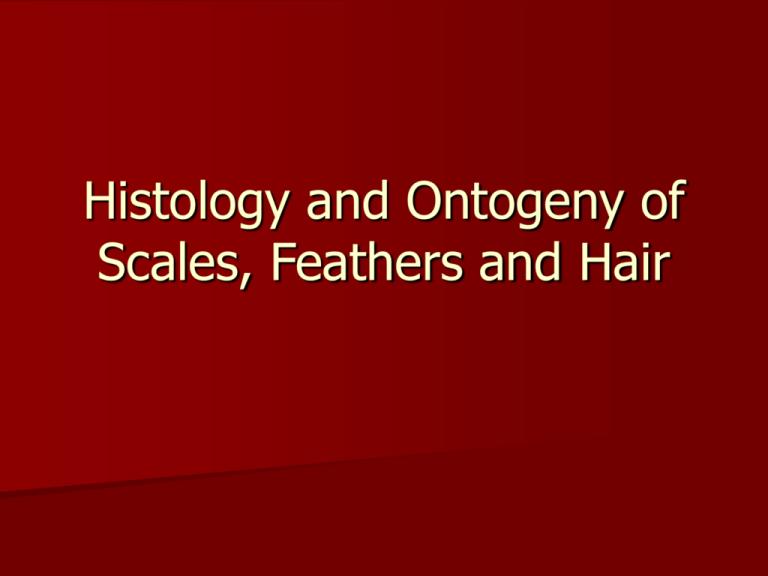
Histology and Ontogeny of Scales, Feathers and Hair The Integument “Jack-of-all-Trades” organ system Forms interface b/w the internal and external environment – Homeostasis – Protection from abrasion – Buffers drastic environmental change Na, HOH, UV – Exchange of chemicals and gases (receptors) Protective Communicative Nutritive – Coloration Protection Communication Structure and Function correlated with an organisms life style and environment Integument - Structure and Development Epidermis – Stratified, squamous – Ectoderm Basement Membrane – Fibrils Dermis – Fibrous connective tissue – Mesodermal dermatome of the somites Integument - Structure and Development Stratum germinativum – – – – – Cuboidal Mitotic Division Migrate Distally Differentiate Sloughed off Synthesis of keratin – Water insoluble protein that fills cells – Stratum corneum of Vertebrates Integument - Structure and Development Beneath the Basement Membrane (Dermis) – Proximal Migration and differentiation of of collagen fibers and other structures – Two layers – – Stratum laxum (spongiosum) Stratum compactum Blood vessels, nerves, pigment cells Endotherms – bases of hair and feathers + erector muscles “Ancient and persistent potential to form bone” Interaction between dermis and epidermis Bony scales Horny scales Feathers Hair Other skin derivatives – claws, antlers, horns, baleen Cells that form the skin layers – Respond to inductive influences of adjacent cells and to environmental influences. Neural crest cells migrating between epidermis and dermis signal the building of these derivatives Integument of Fishes Fish are aquatic – Conservation of structure and function among the different fish groups. – Bony scales Characterize the skin of most fishes Substances (tissues) that contribute to bony scales – Bone – Dentine – Enamel Function of bony scales Protection from parasites, other predators Positioning: – Slide one atop the next – Allow for the distortion of body Hydrodynamic function to reduce drag Feeding Cellular Bone – Extra-cellular matrix of collagen fibers – Embedded in polysaccharide ground substance – Matrix laid down by osteoblasts Differentiate from mesenchyme cells of the dermis – Calcium phosphate crystals (hydroxyapatite) bind to fibers – During osteogenesis Osteoblasts mature and become entrapped in matrix – osteocytes Osteocytes are located in lacunae – Small cavities interconnected by canals (canaliculi) – Cell processes are extended through these canals Bone of fish scales – “dermal bone” (cf. “cellular bone”) Bony scales Bone is deposited by osteocytes on the periphery of a developing scale Osteocytes move centrifugally away from center of scale No bone cells or processes are left behind Then dentine and enamel layers can be added to the surface of the bone for increased hardness of scale Dentine and Enamel Mesenchymal aggregation (papilla) beneath basement membrane Basal cells above the papillae respond and differentiate into ameloblasts – Ameloblasts – collectively called the enamel organ – Secrete enamel – Retreat Underlying dermal cells differentiate into odontoblasts – secrete dentine – Retreat in direction opposite of ameloblasts – Leave long cytoplasmic processes – dentine tubules Types of Scales Four general types: Placoid scales – paleozoic sharks, elasmobranchs – Also called dermal denticles – Spinous process From dermis – Dentine, surrounding a vascular pulp cavity and capped by enamel – Become teeth at jaws Types of Bony Scales Cosmoid plates and scales – Ostracoderms – Cosmine – “dentine” Ganoid plates and scales – Actinopterygian fishes – Bichirs (Polypterus), Garpikes Types of Bony Scales Modern – Cycloid and Ctenoid – Most teleosts Horny Scales Scales of reptiles – “scale” Many layers of cells Thick stratum corneum – Keratin with phospholipids Outer epidermal generation Inner epidermal generation – Function Protection Reduce water loss Feathers Most conspicuous integumental derivative Keratin Function – Flight – Heat Conservation Reduced convective and evaporative heat loss Increased insulation Feathers Types – Contour feathers Flight feathers on tail and wings – Down – Filoplumes Rachis Calamus Barbs reduced or lost Rictal bristles Feathers Development triggered by an interaction b/w epidermis and dermal mesenchyme Formation of dermal papilla (placode) Mitotic divisions in a collar zone of the stratum germinativum near the base of the papilla form a crown of barbs Covered by a horny sheath of epidermis Feathers As development proceeds: – Differential cell division on one side of the papilla Timing of expression of two proteins: Shh & Bmp2 – These cells form a shaft away from the body carrying the barbs that are formed in the collar – The base of the feather recedes into the skin Accompanied by layers of epithelial cells Feather follicle – Degeneration of epidermal sheath Feather morphogenesis Contour feather movie from John Fallon’s lab at UWisc Cross-section of feather follicle 1. Barb ridges of epithelial 2. Surrounding dermal core of connective tissue 3. Space of the follicle 4. Epithelial tissue of follicle 5. Associated musculature Hair Keratinized derivative of mammalian skin Function – Protective – Insulation – Tactile Hair Structure – Shaft of dead, cornified cells – Base is embedded in follicle in the dermis – Follicle wall composed of epidermal cells Hair Development Shaft Follicle Epidermis Dermis Root Hair papilla Cuticle Cortex Medulla Air vacuole Hair Hair Hair derivatives • Antlers – Cervidae – Bony outgrowths, shed annually. • True horns – Bovidae – Bony cores covered with horny sheaths; permanent. • • • SLIDE 35. BMP2 and SHH expression in the scale and feather rudiments. (Harris et al., 2002) What about the creation of a new morphological structure--a novelty. Avian feathers have long been proposed as an evolutionary novelty. But the mechanism to produce feathers has remained elusive. However, a paper recently published from John Fallon's laboratory provides a developmental mechanism by which feathers can be generated from scales. They provide evidence that the differences in the expression of sonic hedgehog and BMP proteins separate the feather from the scale. Both the scale and the feather start off the same way, with the separation of BMP2 and SHH- secreting domains. However, in the feather, both domains shift to the distal region of the appendage. Moreover, this pattern becomes repeated serially around the proximal distal axis. The interaction between BMP2 and Shh then causes each of these regions to form its own axis--the barb of the feather. Matt Harris and others in the Fallon laboratory have shown that when you alter the expression of Shh or BMP2, you change the feather pattern. The results correspond exceptionally well to a proposed mechanism of feather production from archosaurian scales.
